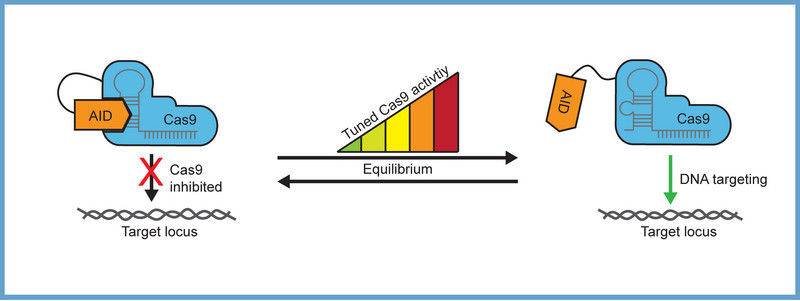Fine-tuning gene scissors
Computer model for adjusting CRISPR-Cas9 enables more precise cuts in the genome
Advertisement
The CRISPR-Cas9 gene-editing tool makes it possible to modify the genetic material of organisms. But CRISPR technology is not perfect. Frequently, these molecular “scissors” also make incisions in genetic regions that have a similar appearance to the target sequence. Researchers at the Berlin Institute of Health (BIH), Charité - Universitätsmedizin Berlin and Heidelberg University Hospital have developed a computer model that can be used to reduce such unwanted “off-target effects.”

Attenuated gene scissors are more precise: coupling the CRISPR-Cas9 gene-editing tool to an artificial inhibitory domain (AID) reduces the tool’s activity.
BIH - Berlin Institute of Health
The CRISPR-Cas9 gene-editing tool is considered a key biotechnological innovation with enormous potential for both basic research and clinical application in the field of gene therapy. However, these “gene scissors” are not always 100 percent precise. “Imagine our genetic make-up as a big shelf with lots of books,” explains Dr. Dominik Niopek, researcher at Heidelberg University’s Hospital and BioQuant Center. “The CRISPR gene-editing tool can find it difficult to distinguish between very similar words in these books – it makes mistakes.”
Together with Professor Roland Eils, director of the Digital Health Center at BIH and Charité – Universitäsmedizin Berlin, Niopek started to look for ways to improve the precision of these molecular scissors. Eils explains that the pivotal idea was to reproduce the individual steps of genome editing in a computer model. In doing so, the researchers made an interesting observation: “The more active the gene scissors are, the more likely they are to make mistakes,” says Eils.
The researchers then set out to reduce the activity of the CRISPR tool in such a way that it still efficiently cuts the desired target sequence in the genome, but no longer targets similar sequences. Using molecular biological methods, they created hybrids from the CRISPR technology and so-called anti-CRISPR proteins, which reduce the activity of the gene-editing tool. The researchers then compared the artificially weakened CRISPR system with the original variant in cell cultures. “In many cases, the weakened gene scissors are indeed more accurate – though the increase in precision depends on the genome sequence being targeted,” explains Sabine Aschenbrenner, a technical assistant in Eils’ department who is co-lead author of the study with BIH bioinformatician and systems physician Dr. Stefan Kallenberger.
Beyond the laboratory, the fine-tuning of CRISPR technology could also have future relevance for patient applications. “Sustained high activity can lead to undesirable side effects in CRISPR gene-editing technology,” says Dominik Niopek. “The ability to quantitatively understand this phenomenon and to control the activity of the tool accordingly is therefore very important for the therapeutic use of this technology.”





















































